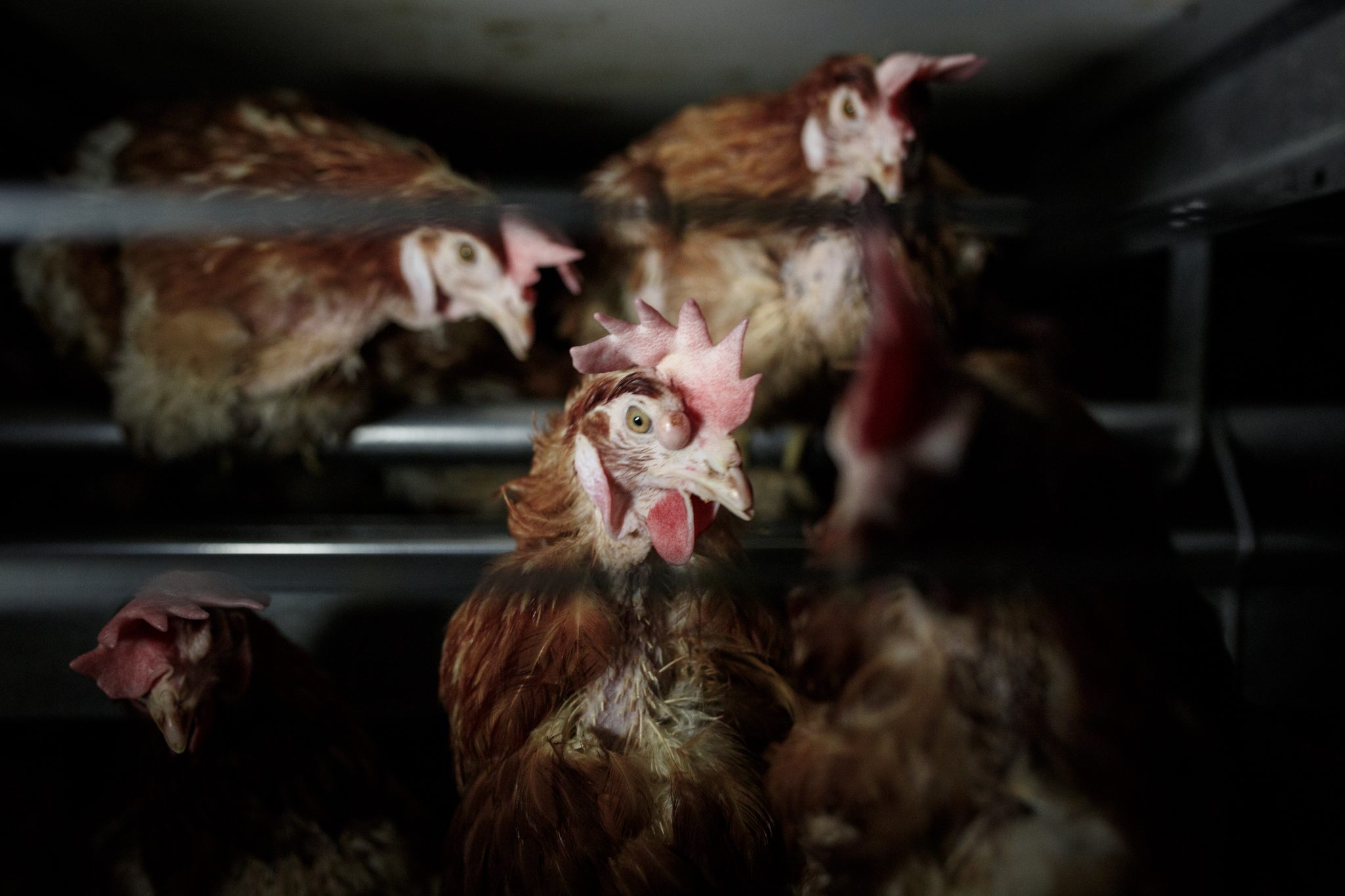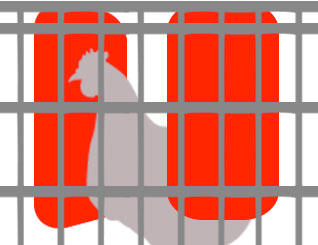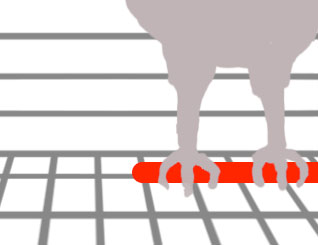Colony cages
After years of hard work from SAFE and other animal rights groups, cruel battery cages were banned in 2023. However, instead of removing cages altogether, the industry now confines hens in colony cages.
Colony cages are bigger than battery cages, but more hens are packed into them, so the experience for hens is virtually the same. Colony cages still breach New Zealand’s Animal Welfare Act 1999 as they do not allow hens to express their natural behaviour.
Currently almost 1.2 million hens are trapped in colony cages across Aotearoa.

Colony cages are stacked to the ceiling in rows inside huge, windowless sheds. Each colony cage will house up to 80 hens, only allowing each hen the size of an A4 piece of paper (750 square centimetres of space) to live out their lives.
Every day is the same for a hen in a colony cage: she will wait her turn to lay in the ‘nest area’, a rubber mat covered in excrement, compete with the other hens for space on the slippery metal perches, or attempt digging on the ‘scratch pad’, a small rubber square. She will never get to go outside, move around freely, scratch in the dirt, or rest comfortably.
Overcrowded conditions inside colony cages can cause hens to experience elevated levels of distress. This can lead to aggressive behaviour like pecking, feather pulling and cannibalism. To minimise aggression, lighting within sheds is kept dim and hens have the tips of their sensitive beaks removed to reduce pecking injuries.
The physical health of caged hens is frequently poor. Stress, disease, severe feather loss and brittle bones (weakened from lack of movement) are just some of the serious health issues hens may experience.
Hens in colony cages may also experience emotional distress, including anxiety, stress, boredom and fear. If aggressive hens are present inside a cage, submissive, sick or injured hens have nowhere to seek refuge.
The day to day life of a caged hen is bleak, and it doesn’t have to be.
Colony Cages: Quick Facts
Are colony cages different to battery cages?
Yes. In December 2012, the Government released a new welfare code for hens kept to lay eggs which banned the standard battery cage. Colony cages have been approved as the new caged system to replace battery cages. They are bigger, but contain more hens, so the experience for hens is virtually the same. Colony cages have been labelled as “enriched” or “furnished” because the hens are provided with perches, a small rubber scratch pad and a single nest box. While these enrichments may sound good on paper, the reality is far from it. With so many hens confined to one cage, competition to access these minimal “enrichments” can cause hens to become frustrated and aggressive. With only one nest box in a cage housing over 60 hens, hens can become irritated, pace and delay laying their eggs.
What are colony cages?
Colony cages are a new type of battery cage. In order to meet the new code of the welfare for hens kept to lay eggs, colony cages provide “enrichments” for these hens. These enrichments are minimal and the hens spend their lives confined in overcrowded and unnatural conditions. Cage sizes vary, but each hen must have about the size of an A4 sheet of paper (750 square centimetres), just slightly more space than in a standard battery cage.
Hens confined to colony cages cannot walk around freely or stretch or flap their wings properly and are unable to retreat or hide from the aggressive hens kept in the same cage.
What are the ‘enrichments’ found in colony cages?
“Nest boxes”

Colony cages provide only one “nest box” for up to 60 hens. Competition for access to the nest box can cause hens to experience frustration, to constantly pace around the cage and to delay laying their eggs. These nest boxes are nothing more than an area with hanging plastic flaps, no bedding material is provided.
“Scratch pads”

Scratch pads are rubber mats which are provided for the hens to use to shorten their claws. The hens remain unable to scratch the ground and look for food, which are activities hens would enjoy when outdoors.
“Perches”
Colony cages contain perches for the hens to roost on, however high flock numbers make accessing the perches difficult. Hens naturally roost at night in order to escape predators. The perches in colony cages are too low to be perceived as safe by the hens and offer little protection to hens trying to escape from aggressive hens kept in the same cage.
What do the terms colony laid and colony system mean?
Hens who lay eggs in colony-cages may have their eggs labelled with terms such as ‘colony laid’ and ‘colony system.’ This is marketing speak used to mislead the public into buying cage eggs, as the majority of people are against keeping hens in cages.
Check out our Guide to Egg Labels for more information.
What is a furnished system?
This is another term that may be used to refer to colony cages, a term typically used overseas.
Are colony systems used overseas?
Colony cages are already being phased out in parts of Europe, such as Switzerland, Luxembourg, Germany, the Walloon Region of Belgium and Austria. Some states Washington, Oregon, Michigan and California in the United States have legal bans on the sale and production of cage eggs and farms are changing to cage-free systems.
What are the alternatives to buying colony eggs?
Many people assume that free range farming gives animals a happy life, free of the cruelty of a factory farm. There are some important things you should know before choosing this option. Many people opt to avoid eggs. This is a healthy choice, it is easy, and there are many alternatives to cooking and baking with eggs.

